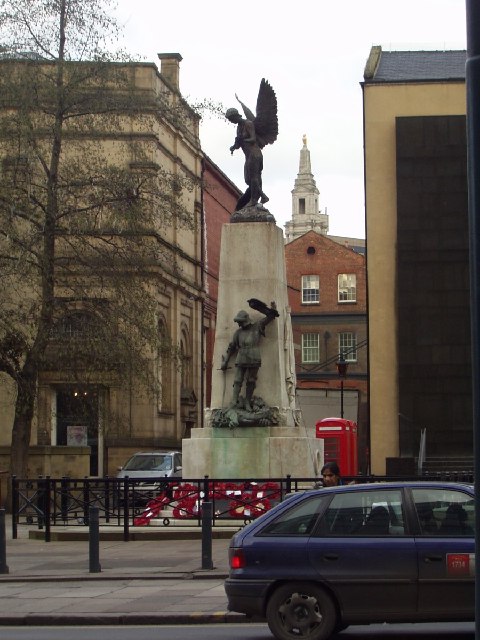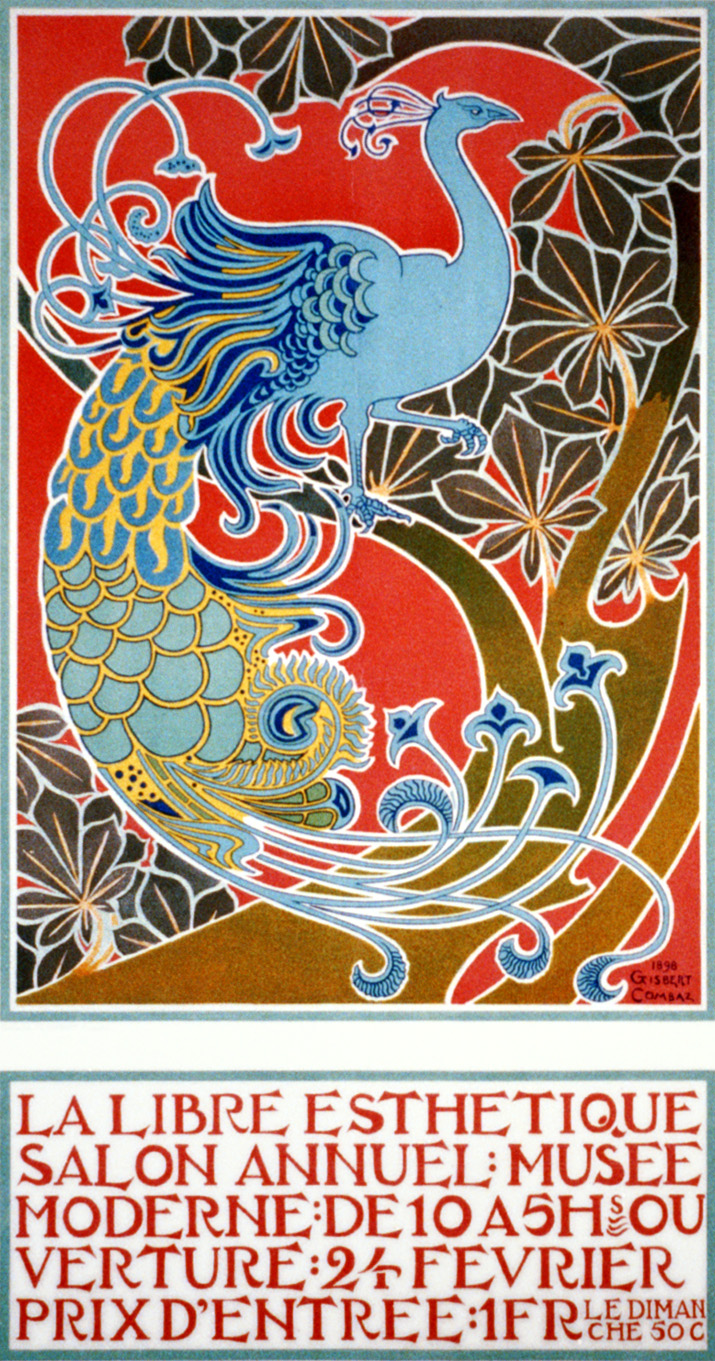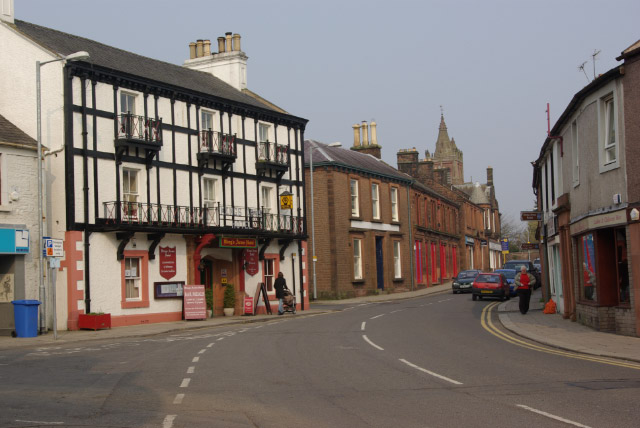|
Henry Charles Fehr
Henry Charles Fehr Royal British Society of Sculptors, FRBS (4 November 1867 – 13 May 1940) was a British monumental and architectural sculptor active in the late nineteenth and early twentieth centuries. He produced several notable public sculptures, war memorials and works for civic buildings. These included architectural sculptures for Middlesex Guildhall, for Wakefield County Hall and for City Hall, Cardiff, Cardiff City Hall. Throughout the 1920s, Fehr created a number of war memorials, often featuring detailed bronze statuary, for British towns and cities. Notable examples of Fehr's war memorials include those at Leeds War Memorial, Leeds, Colchester, Keighley and at Burton upon Trent. Biography Fehr was born in Forest Hill, London, Forest Hill in south-east London into a Swiss family, who had settled in England. Fehr attended the City of London School and is thought to have trained as an apprentice in the studio of the sculptor and stonemason Horace Montford, who support ... [...More Info...] [...Related Items...] OR: [Wikipedia] [Google] [Baidu] |
Forest Hill, London
Forest Hill is a district of the London Borough of Lewisham in south London, south east London, England, on the South Circular Road, London, South Circular Road, which is home to the Horniman Museum. History Like much of London, Forest Hill was only sparsely populated until the mid-19th century. The name Forest Hill, originally simply "The Forest",Hibbert, C. ''The London Encyclopedia'', Macmillan, p. 304 referred to the woodland which once covered the areaField, J. ''Place names of Greater London'', Batsford, 1980, p.49 and which was a relict part of the Great North Wood. In 1809, the Croydon Canal opened, however, the large number of locks (28) meant it was not a commercial success, and it was bought by the London & Croydon Railway Company who used the alignment to construct the Brighton Main Line, London Bridge to Croydon railway line opening in 1839. The ponds in the Dacres Wood Nature Reserve and the retaining wall of the footpath opposite the station outside the pub ... [...More Info...] [...Related Items...] OR: [Wikipedia] [Google] [Baidu] |
James Glen Sivewright Gibson
James Glen Sivewright Gibson (23 November 1861 – 27 March 1951) was a British architect active in the late nineteenth and early twentieth centuries. Life and career Gibson was born in Arbroath the son of William Gibson and Elizabeth Sivewright and the brother of Robert Gibson, civil engineer and architect, practising in Dundee. He was articled to Ireland & Maclaren, Dundee, from 1877 to 1881, and was thereafter a draughtsman with Pearce Brothers, engineers, and then with Alexander Hutcheson. He subsequently moved to London and worked for William Wallace, Harry Wilkinson Moore, and finally Thomas Edward Collcutt. At some point he travelled in France and Italy before commencing practice and passing the qualifying exam, both in 1889. He was admitted an Associate of the Royal Institute of British Architects, his proposers being the Dundee architect John Murray Robertson, Collcutt and James Brooks. In that year, he set up in independent practice. In 1890, Gibson entered into par ... [...More Info...] [...Related Items...] OR: [Wikipedia] [Google] [Baidu] |
Art Workers Guild
The Art Workers' Guild is an organisation established in 1884 by a group of British painters, sculptors, architects, and designers associated with the ideas of William Morris and the Arts and Crafts movement. The guild promoted the 'unity of all the arts', denying the distinction between fine and applied art. It opposed the professionalisation of architecture – which was promoted by the Royal Institute of British Architects at this time – in the belief that this would inhibit design. In his 1998 book, ''Introduction to Victorian Style'', University of Brighton's David Crowley stated the guild was "the conscientious core of the Arts and Crafts Movement". History The guild was not the first organisation to promote the unity of the arts. Two organisations, the Fifteen and St George's Art Society had existed previously, and the guild's founders came from the St George's Art Society. They were five young architects from Norman Shaw's office: W. R. Lethaby, Edward Prior, Ernest ... [...More Info...] [...Related Items...] OR: [Wikipedia] [Google] [Baidu] |
William Morris Gallery
The William Morris Gallery is a museum devoted to the life and works of William Morris, an English Arts and Crafts designer and early socialist. It is located in Walthamstow at Water House, a substantial Grade II* listed Georgian home. The extensive grounds of the building are a public park, known as Lloyd Park. Collections and exhibits The William Morris Gallery holds the most comprehensive collection of objects relating to all aspects of Morris's life and work, including his work as a designer, a writer and a social activist. The permanent exhibit is divided into 9 rooms: *''1. Meet the Man'', Morris' early life and background; *''2. Starting Out'', Morris' early works and his influences including Pre-Raphaelite artists and Art Critic John Ruskin; *''3. Morris & Co'', the formation and ideal's of Morris' design company; *''4. The Workshop'', the design and manufacturing techniques championed by Morris; *''5. The Shop'', an interactive gallery exploring the experience of sh ... [...More Info...] [...Related Items...] OR: [Wikipedia] [Google] [Baidu] |
William Morris
William Morris (24 March 1834 – 3 October 1896) was a British textile designer, poet, artist, novelist, architectural conservationist, printer, translator and socialist activist associated with the British Arts and Crafts Movement. He was a major contributor to the revival of traditional British textile arts and methods of production. His literary contributions helped to establish the modern fantasy genre, while he helped win acceptance of socialism in ''fin de siècle'' Great Britain. Morris was born in Walthamstow, Essex, to a wealthy middle-class family. He came under the strong influence of medievalism while studying Classics at Oxford University, there joining the Birmingham Set. After university, he married Jane Burden, and developed close friendships with Pre-Raphaelite artists Edward Burne-Jones and Dante Gabriel Rossetti and with Neo-Gothic architect Philip Webb. Webb and Morris designed Red House in Kent where Morris lived from 1859 to 1865, before moving t ... [...More Info...] [...Related Items...] OR: [Wikipedia] [Google] [Baidu] |
La Libre Esthétique
''La Libre Esthétique'' ( French; "The Free Aesthetics") was an artistic society founded in 1893 in Brussels, Belgium to continue the efforts of the artists' group ''Les XX'' dissolved the same year. To reduce conflicts between artists invited or excluded, artists were no longer admitted to the society, thus all exhibitors were now invited. The first annual exhibition was opened on 14 February 1894, and the exhibition of 1914 was the last: a year later German troops had occupied Belgium, Brussels included. The Annual Exhibitions, 1894-1913 All exhibitions were accompanied by a bibliophile catalogue, printed at Veuve Monnon, Brussels. 1894 * First exhibition, 17 February - 15 March 1894 Paul Gauguin Eugène Henri Paul Gauguin (, ; ; 7 June 1848 – 8 May 1903) was a French Post-Impressionist artist. Unappreciated until after his death, Gauguin is now recognized for his experimental use of colour and Synthetist style that were distinct fr ... showed five paintings, one from ... [...More Info...] [...Related Items...] OR: [Wikipedia] [Google] [Baidu] |
Keighley
Keighley ( ) is a market town and a civil parish in the City of Bradford Borough of West Yorkshire, England. It is the second largest settlement in the borough, after Bradford. Keighley is north-west of Bradford city centre, north-west of Bingley, north of Halifax and south-east of Skipton. It is governed by Keighley Town Council and Bradford City Council. Keighley sits between the counties of West Yorkshire, North Yorkshire and Lancashire. Historically in the West Riding of Yorkshire, it lies between Airedale and Keighley Moors. At the 2011 census, Keighley had a population of 56,348. History Toponymy The name Keighley, which has gone through many changes of spelling throughout its history, means "Cyhha's farm or clearing", and was mentioned in the Domesday Book of 1086: "In Cichhelai, Ulchel, and Thole, and Ravensuar, and William had six carucates to be taxed." Town charter Henry de Keighley, a Lancashire knight, was granted a charter to hold a market in Keighley ... [...More Info...] [...Related Items...] OR: [Wikipedia] [Google] [Baidu] |
Grangetown, Cardiff
Grangetown (Welsh: usually ''Grangetown'', also Trelluest) is a district and community in the south of Cardiff, capital of Wales. It is one of the largest districts in the south of the city and is bordered by Riverside, Canton and Butetown. The River Taff winds its way through the area. Adjacent to the city's Cardiff Bay area, Grangetown is experiencing a period of gentrification and improvements in its infrastructure. Its population as of 2011 was 19,385 in 8,261 households. One of the "five towns of Cardiff", the others are Butetown, Crockherbtown, Newtown and Temperance Town. Grangetown is a diverse and multiracial district and has a significant population of Somali, Asian and mixed-race residents. It is home to a Swaminarayan Temple and various mosques. Etymology The name ''Grangetown'' is the usual form in Welsh. The variants ''Y Grange'' (dating back to the nineteenth century) and ''Y Grênj'' (equivalents of ''The Grange'') are sometimes seen. Owen John Thomas has ... [...More Info...] [...Related Items...] OR: [Wikipedia] [Google] [Baidu] |
Langholm
Langholm , also known colloquially as the "Muckle Toon", is a burgh in Dumfries and Galloway, southern Scotland. Langholm lies between four hills in the valley of the River Esk in the Southern Uplands. Location and geography Langholm sits north of the Anglo-Scottish border on the A7 road running between Edinburgh and Carlisle. Edinburgh is to the north, Newcastleton is around to the east and Carlisle to the south. Langholm is surrounded by four hills in the River Esk valley within Scotland's wider Southern Uplands. The highest of the four hills is 300 m high Whita hill on which stands an obelisk (locally known as 'The Monument'). The Monument commemorates the life and achievements of Sir John Malcolm (1769‑1833), former soldier, statesman, and historian. The other three hills are Warblaw (in Langholm it is pronounced Warbla), Meikleholmhill (a knowe of which is known as 'Timpen') and the Castle Hill. The two longest B roads in the UK both start (or finish) in Lang ... [...More Info...] [...Related Items...] OR: [Wikipedia] [Google] [Baidu] |
Lockerbie
Lockerbie (, gd, Locarbaidh) is a small town in Dumfries and Galloway, south-western Scotland. It is about from Glasgow, and from the border with England. The United Kingdom Census 2001, 2001 Census recorded its population as 4,009. The town came to international attention in December 1988 when the wreckage of Pan Am Flight 103 crashed there following a terrorism, terrorist bomb attack aboard the flight. Prehistory and archaeology In 2006, ahead of the construction of a new primary and secondary school archaeologists from CFA Archaeology under took excavations. They discovered the remains of a large (27 x 8m) Neolithic British Isles, Neolithic timber hall that dated to somewhere between 3950 BC to 3700 BC. The archaeologists found it was in use for some time as some of the posts had been replaced. Flax seeds were found in the timber hall showing the people were processing flax. This is an extremely rare find with only one other site in Scotland showing evidence of flax produc ... [...More Info...] [...Related Items...] OR: [Wikipedia] [Google] [Baidu] |
Royal Academy
The Royal Academy of Arts (RA) is an art institution based in Burlington House on Piccadilly in London. Founded in 1768, it has a unique position as an independent, privately funded institution led by eminent artists and architects. Its purpose is to promote the creation, enjoyment and appreciation of the visual arts through exhibitions, education and debate. History The origin of the Royal Academy of Arts lies in an attempt in 1755 by members of the Society for the Encouragement of Arts, Manufactures and Commerce, principally the sculptor Henry Cheere, to found an autonomous academy of arts. Prior to this a number of artists were members of the Society for the Encouragement of Arts, Manufactures and Commerce, including Cheere and William Hogarth, or were involved in small-scale private art academies, such as the St Martin's Lane Academy. Although Cheere's attempt failed, the eventual charter, called an 'Instrument', used to establish the Royal Academy of Arts over a decad ... [...More Info...] [...Related Items...] OR: [Wikipedia] [Google] [Baidu] |
World War I
World War I (28 July 1914 11 November 1918), often abbreviated as WWI, was one of the deadliest global conflicts in history. Belligerents included much of Europe, the Russian Empire, the United States, and the Ottoman Empire, with fighting occurring throughout Europe, the Middle East, Africa, the Pacific, and parts of Asia. An estimated 9 million soldiers were killed in combat, plus another 23 million wounded, while 5 million civilians died as a result of military action, hunger, and disease. Millions more died in genocides within the Ottoman Empire and in the 1918 influenza pandemic, which was exacerbated by the movement of combatants during the war. Prior to 1914, the European great powers were divided between the Triple Entente (comprising France, Russia, and Britain) and the Triple Alliance (containing Germany, Austria-Hungary, and Italy). Tensions in the Balkans came to a head on 28 June 1914, following the assassination of Archduke Franz Ferdin ... [...More Info...] [...Related Items...] OR: [Wikipedia] [Google] [Baidu] |



.jpg)
.jpg)

